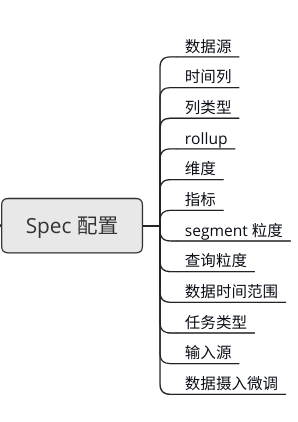OLAP 数据平台 Druid 第一步,编写 Spec 配置
本文参考 Druid 官方文档。
Apache Druid 是一个集时间序列数据库、数据仓库和全文检索系统特点于一体的分析性数据平台(OLAP)。Druid 作为一个高可用、高性能和多特性的 OLAP 平台,使用场景丰富。

Druid 使用场景
许多互联网公司基于 Druid 搭建 OLAP 数据分析和 BI 平台。如:
● 快手万亿级实时 OLAP 平台的建设与实践:
https://www.infoq.cn/article/IWfHmTig_KNAeEJKF8eS
● Druid 在有赞的实践:
https://zhuanlan.zhihu.com/p/25593670
● Druid 在小米公司的技术实践:
https://zhuanlan.zhihu.com/p/25593670
此前 Druid 系列文章已经详解过 Druid 的特性、使用场景、架构和实现原理。可以参考:
● 时间序列数据库(TSDB)初识与选择
● 十分钟了解 Apache Druid
● Apache Druid 的集群设计与工作流程
● Apache Druid 底层存储设计(列存储与全文检索)
本文将指导读者完整定义一个完整 Spec,并指出关键注意事项。Spec 是 Druid 数据摄入的配置信息,使用 json 格式,使用 Druid 时可以通过界面配置,最后生成 Spec 文件,也可以直接编写 Spec 文件,然后上传配置。无论使用哪种方式,深入了解 Spec 的编写既是开始使用 Druid 的第一步,也是深入了解 Druid 各种概念,继而深入了解 Druid 原理的必经之路。
示例数据
假设我们有以下网络流量数据:
● srcIP: 发送端 IP 地址
● srcPort: 发送端端口号
● dstIP: 接收端 IP 地址
● dstPort: 接收端端口号
● protocol: IP 协议号
● packets: 传输的包的数量
● bytes: 传输字节数
● cost: 传输耗费的时间
{"ts":"2018-01-01T01:01:35Z","srcIP":"1.1.1.1", "dstIP":"2.2.2.2", "srcPort":2000, "dstPort":3000, "protocol": 6, "packets":10, "bytes":1000, "cost": 1.4}
{"ts":"2018-01-01T01:01:51Z","srcIP":"1.1.1.1", "dstIP":"2.2.2.2", "srcPort":2000, "dstPort":3000, "protocol": 6, "packets":20, "bytes":2000, "cost": 3.1}
{"ts":"2018-01-01T01:01:59Z","srcIP":"1.1.1.1", "dstIP":"2.2.2.2", "srcPort":2000, "dstPort":3000, "protocol": 6, "packets":30, "bytes":3000, "cost": 0.4}
{"ts":"2018-01-01T01:02:14Z","srcIP":"1.1.1.1", "dstIP":"2.2.2.2", "srcPort":5000, "dstPort":7000, "protocol": 6, "packets":40, "bytes":4000, "cost": 7.9}
{"ts":"2018-01-01T01:02:29Z","srcIP":"1.1.1.1", "dstIP":"2.2.2.2", "srcPort":5000, "dstPort":7000, "protocol": 6, "packets":50, "bytes":5000, "cost": 10.2}
{"ts":"2018-01-01T01:03:29Z","srcIP":"1.1.1.1", "dstIP":"2.2.2.2", "srcPort":5000, "dstPort":7000, "protocol": 6, "packets":60, "bytes":6000, "cost": 4.3}
{"ts":"2018-01-01T02:33:14Z","srcIP":"7.7.7.7", "dstIP":"8.8.8.8", "srcPort":4000, "dstPort":5000, "protocol": 17, "packets":100, "bytes":10000, "cost": 22.4}
{"ts":"2018-01-01T02:33:45Z","srcIP":"7.7.7.7", "dstIP":"8.8.8.8", "srcPort":4000, "dstPort":5000, "protocol": 17, "packets":200, "bytes":20000, "cost": 34.5}
{"ts":"2018-01-01T02:35:45Z","srcIP":"7.7.7.7", "dstIP":"8.8.8.8", "srcPort":4000, "dstPort":5000, "protocol": 17, "packets":300, "bytes":30000, "cost": 46.3}将上面 JSON 内容保存到 $druid_root\quickstart\目录下的 ingestion-tutorial-data.json 文件中。
下面我们开始编写一个 Spect 将上面的数据写入 Druid。
在本教程中,我们将使用本地批处理indexing任务。如果使用其他任务类型,摄入规范的某些地方将会不一样,我们将在教程中指出。
下面将详细讲解 Spec 配置,你将了解以下内容:

内容
定义 schema
Druid 摄入 spec 的核心元素是 dataSchema 。dataSchema 定义如何将输入的数据解析成 Druid 能够存储的列集合。
我们从一个空的dataSchema 开始,并按教程一步步添加字段。
在quickstart/ 目录下创建 ingestion-tutorial-index.json 文件,将以下内容写入文件:
"dataSchema" : {}
随着教程的进行,我们将不断的修改此 spec 文件。
数据源名称
数据源名称通过dataSchema 下的 dataSource 参数指定。dataSource 类似于 RDBMS 的 Table Name,写入的数据通过此名称查询,如:select * from $dataSource。
"dataSchema" : {
"dataSource" : "ingestion-tutorial",
}让我们将教程中的数据源命名为 ingestion-tutorial。
时间列
dataSchema 需要知道如何从输入的数据中提取主时间字段。Druid 的数据必须有时间字段,Druid 底层按时间分 segment 来存储数据,详情可以参考《Apache Druid 的集群设计与工作流程》。
我们数据中的时间戳列是"ts",它是一个 ISO 8601 规范的时间戳,我们将配置此字段的 timestampSpec信息加到 dataSchema 下:
"dataSchema" : {
"dataSource" : "ingestion-tutorial",
"timestampSpec" : {
"format" : "iso",
"column" : "ts"
}
}列类型
现在,我们已经定义了时间列,让我们看一下其他列的定义。
Druid 支持以下列类型:String,Long,Float,Double。下面章节中我们将看到这些类型如何被使用。
在我们讲如何定义其他非时间列之前,先讨论一下 rollup。
Rollup
在摄入数据时,我们需要考虑是否需要 rollup。
● 如果开启 rollup,需要将输入数据列分成两种类型,维度(dimension)和指标(metric)。维度是 rollup 的 grouping 列(用于 group by,filtering),指标是被聚合计算的列。
● 如果不开启 rollup,所有列都被视为维度,将不会进行预聚合。
在此教程中,我们开启 rollup。在 dataSchema 的 granularitySpec中指定:
"dataSchema" : {
"dataSource" : "ingestion-tutorial",
"timestampSpec" : {
"format" : "iso",
"column" : "ts"
},
"granularitySpec" : {
"rollup" : true
}
}选择维度和指标
在此教程中,我们按以下方式划分维度列和指标列:
● Dimensions: srcIP, srcPort, dstIP, dstPort, protocol
● Metrics: packets, bytes, cost
这些维度是一组属性,用以标识一组网络流量数据,而指标代表按此维度组合的网络流量的实际情况。
让我们看看如何在 spec 中定义维度和指标吧。
维度
维度由 dataSchema 中的 dimensionsSpec 参数指定。
"dataSchema" : {
"dataSource" : "ingestion-tutorial",
"timestampSpec" : {
"format" : "iso",
"column" : "ts"
},
"dimensionsSpec" : {
"dimensions": [
"srcIP",
{ "name" : "srcPort", "type" : "long" },
{ "name" : "dstIP", "type" : "string" },
{ "name" : "dstPort", "type" : "long" },
{ "name" : "protocol", "type" : "string" }
]
},
"granularitySpec" : {
"rollup" : true
}
}每个维度都有一个 name 和 一个 type ,其中 type 可以是"long", "float", "double", or "string"。
注意,srcIP 是一个 "string" 维度。对于字符串维度,只需要指定维度的名称就可以了,因为它的类型默认为"string"。
也请注意, protocol 在输入数据中是数字类型,但我们以 "string" 列类型提取它,所以 Druid 在摄入数据时会将其强制由 long 类型转换成 string 类型。
Strings vs Numbers
数字类型的数据应该作为数字维度还是字符串维度?
数字维度相对于字符串维度有以下优势和劣势:
● 优势:数字需要更小的存储空间,并且在读取该列时需要更小的开销。
● 劣势:数字维度没有索引,所以按此列 filter 的操作会比字符串类型的维度(这种维度有索引)更慢。
指标
指标通过 dataSchema 中的 metricsSpec 参数指定:
"dataSchema" : {
"dataSource" : "ingestion-tutorial",
"timestampSpec" : {
"format" : "iso",
"column" : "ts"
},
"dimensionsSpec" : {
"dimensions": [
"srcIP",
{ "name" : "srcPort", "type" : "long" },
{ "name" : "dstIP", "type" : "string" },
{ "name" : "dstPort", "type" : "long" },
{ "name" : "protocol", "type" : "string" }
]
},
"metricsSpec" : [
{ "type" : "count", "name" : "count" },
{ "type" : "longSum", "name" : "packets", "fieldName" : "packets" },
{ "type" : "longSum", "name" : "bytes", "fieldName" : "bytes" },
{ "type" : "doubleSum", "name" : "cost", "fieldName" : "cost" }
],
"granularitySpec" : {
"rollup" : true
}
}在定义指标时,必须指定当前列在 rollup 时应该执行的聚合类型。
这里,我们在 packets 和 bytes 两个指标列上定义了 long 类型的 sum 聚合,在 cost 列上定义了一个 double 的 sum 聚合。
注意 metricsSpec 与 dimensionSpec 和 parseSpec 的嵌套层级不一样。它和 dataSchema 中的 parser在同一嵌套层级。
注意,我们也定义了一个 count 聚合器。这个计数聚合器将统计原始数据摄入的行数。
No rollup
如果我们不使用 rollup,将在 dimensionsSpec 中指定所有列,如:
"dimensionsSpec" : {
"dimensions": [
"srcIP",
{ "name" : "srcPort", "type" : "long" },
{ "name" : "dstIP", "type" : "string" },
{ "name" : "dstPort", "type" : "long" },
{ "name" : "protocol", "type" : "string" },
{ "name" : "packets", "type" : "long" },
{ "name" : "bytes", "type" : "long" },
{ "name" : "srcPort", "type" : "double" }
]
},定义粒度
此时,我们已经完成了 parser 和 metricSpec 的定义,并几乎要完成 Spec 的 dataSchema 。
我们还需要在 granularitySpec 中设置一些额外的参数:
● granularitySpec 类型:支持两种类型——uniform 和 arbitrary 。在本教程中,我们将使用 uniform,这样所有的 segment 将有统一的时间范围大小(本示例中,所有 segment 覆盖一个小时的数据量)。
● segment 粒度:设置单个 segment 应该包含多大时间范围的数据,如:DAY,WEEK 。
● 时间列中时间戳的 buckting 粒度(称为查询粒度 queryGranularity )。
Segment 粒度
segment 粒度通过 granularitySpec 中的 segmentGranularity 属性配置。此文档中,我们将创建 hourly 粒度的 segment:
"dataSchema" : {
"dataSource" : "ingestion-tutorial",
"timestampSpec" : {
"format" : "iso",
"column" : "ts"
},
"dimensionsSpec" : {
"dimensions": [
"srcIP",
{ "name" : "srcPort", "type" : "long" },
{ "name" : "dstIP", "type" : "string" },
{ "name" : "dstPort", "type" : "long" },
{ "name" : "protocol", "type" : "string" }
]
},
"metricsSpec" : [
{ "type" : "count", "name" : "count" },
{ "type" : "longSum", "name" : "packets", "fieldName" : "packets" },
{ "type" : "longSum", "name" : "bytes", "fieldName" : "bytes" },
{ "type" : "doubleSum", "name" : "cost", "fieldName" : "cost" }
],
"granularitySpec" : {
"type" : "uniform",
"segmentGranularity" : "HOUR",
"rollup" : true
}
}我们的输入数据包含两个小时的事件,所以此任务将生成两个 segment。
查询粒度
查询粒度通过 granularitySpec 中的 queryGranularity 属性配置。此教程中,我们使用 minute 级粒度:
"dataSchema" : {
"dataSource" : "ingestion-tutorial",
"timestampSpec" : {
"format" : "iso",
"column" : "ts"
},
"dimensionsSpec" : {
"dimensions": [
"srcIP",
{ "name" : "srcPort", "type" : "long" },
{ "name" : "dstIP", "type" : "string" },
{ "name" : "dstPort", "type" : "long" },
{ "name" : "protocol", "type" : "string" }
]
},
"metricsSpec" : [
{ "type" : "count", "name" : "count" },
{ "type" : "longSum", "name" : "packets", "fieldName" : "packets" },
{ "type" : "longSum", "name" : "bytes", "fieldName" : "bytes" },
{ "type" : "doubleSum", "name" : "cost", "fieldName" : "cost" }
],
"granularitySpec" : {
"type" : "uniform",
"segmentGranularity" : "HOUR",
"queryGranularity" : "MINUTE",
"rollup" : true
}
}为了查看查询粒度配置的效果,让我们从原始输入数据中查看这一行:
{"ts":"2018-01-01T01:03:29Z","srcIP":"1.1.1.1", "dstIP":"2.2.2.2", "srcPort":5000, "dstPort":7000, "protocol": 6, "packets":60, "bytes":6000, "cost": 4.3}
当使用 minute 粒度摄入这行数据时,Druid 将把这行数据的时间戳 floor 成 minute 桶的时间:
{"ts":"2018-01-01T01:03:00Z","srcIP":"1.1.1.1", "dstIP":"2.2.2.2", "srcPort":5000, "dstPort":7000, "protocol": 6, "packets":60, "bytes":6000, "cost": 4.3}
定义时间范围
对于批量任务,必须定义时间范围。在时间范围之外的输入数据将不被摄入。
这个时间范围也在 granularitySpec 中指定:
"dataSchema" : {
"dataSource" : "ingestion-tutorial",
"timestampSpec" : {
"format" : "iso",
"column" : "ts"
},
"dimensionsSpec" : {
"dimensions": [
"srcIP",
{ "name" : "srcPort", "type" : "long" },
{ "name" : "dstIP", "type" : "string" },
{ "name" : "dstPort", "type" : "long" },
{ "name" : "protocol", "type" : "string" }
]
},
"metricsSpec" : [
{ "type" : "count", "name" : "count" },
{ "type" : "longSum", "name" : "packets", "fieldName" : "packets" },
{ "type" : "longSum", "name" : "bytes", "fieldName" : "bytes" },
{ "type" : "doubleSum", "name" : "cost", "fieldName" : "cost" }
],
"granularitySpec" : {
"type" : "uniform",
"segmentGranularity" : "HOUR",
"queryGranularity" : "MINUTE",
"intervals" : ["2018-01-01/2018-01-02"],
"rollup" : true
}
}定义任务类型
现在我们已经完成了 dataSchema 的定义。接下来要做的就是将我们创建的 dataSchema 放入一个数据摄入任务中,并指定输入的源。
dataSchema 适用于所有类型的任务,但每种任务类型都有自生的规范格式。在本教程中,我们使用本地批量数据摄入任务类型(the native ingestion task):
{
"type" : "index_parallel",
"spec" : {
"dataSchema" : {
"dataSource" : "ingestion-tutorial",
"timestampSpec" : {
"format" : "iso",
"column" : "ts"
},
"dimensionsSpec" : {
"dimensions": [
"srcIP",
{ "name" : "srcPort", "type" : "long" },
{ "name" : "dstIP", "type" : "string" },
{ "name" : "dstPort", "type" : "long" },
{ "name" : "protocol", "type" : "string" }
]
},
"metricsSpec" : [
{ "type" : "count", "name" : "count" },
{ "type" : "longSum", "name" : "packets", "fieldName" : "packets" },
{ "type" : "longSum", "name" : "bytes", "fieldName" : "bytes" },
{ "type" : "doubleSum", "name" : "cost", "fieldName" : "cost" }
],
"granularitySpec" : {
"type" : "uniform",
"segmentGranularity" : "HOUR",
"queryGranularity" : "MINUTE",
"intervals" : ["2018-01-01/2018-01-02"],
"rollup" : true
}
}
}
}定义输入源
现在,让我们来定义我们自己的输入源,它在 ioConfig 对象中指定。每种任务类型都有自己的 ioConfig 类型。为了读取输入数据,我们需要指定一个 inputSource。我们之前保存的网络流量数据需要从一个本地文件读取,其配置如下:
"ioConfig" : {
"type" : "index_parallel",
"inputSource" : {
"type" : "local",
"baseDir" : "quickstart/",
"filter" : "ingestion-tutorial-data.json"
}
}定义数据格式
因为我们的数据是 JSON 字符串形式的,我们使用 inputFormat json 格式化数据(还支持 csv、protobuf 等数据类型):
"ioConfig" : {
"type" : "index_parallel",
"inputSource" : {
"type" : "local",
"baseDir" : "quickstart/",
"filter" : "ingestion-tutorial-data.json"
},
"inputFormat" : {
"type" : "json"
}
}{
"type" : "index_parallel",
"spec" : {
"dataSchema" : {
"dataSource" : "ingestion-tutorial",
"timestampSpec" : {
"format" : "iso",
"column" : "ts"
},
"dimensionsSpec" : {
"dimensions": [
"srcIP",
{ "name" : "srcPort", "type" : "long" },
{ "name" : "dstIP", "type" : "string" },
{ "name" : "dstPort", "type" : "long" },
{ "name" : "protocol", "type" : "string" }
]
},
"metricsSpec" : [
{ "type" : "count", "name" : "count" },
{ "type" : "longSum", "name" : "packets", "fieldName" : "packets" },
{ "type" : "longSum", "name" : "bytes", "fieldName" : "bytes" },
{ "type" : "doubleSum", "name" : "cost", "fieldName" : "cost" }
],
"granularitySpec" : {
"type" : "uniform",
"segmentGranularity" : "HOUR",
"queryGranularity" : "MINUTE",
"intervals" : ["2018-01-01/2018-01-02"],
"rollup" : true
}
},
"ioConfig" : {
"type" : "index_parallel",
"inputSource" : {
"type" : "local",
"baseDir" : "quickstart/",
"filter" : "ingestion-tutorial-data.json"
},
"inputFormat" : {
"type" : "json"
}
}
}
}其他调整
每一个摄取任务都有 tuningConfig 配置项,它允许用户调整各种摄取参数。
举例来说,让我们添加一个tuningConfig,以设置本次批量摄取任务的目标 segment 大小:
"tuningConfig" : {
"type" : "index_parallel",
"maxRowsPerSegment" : 5000000
}最终 spec
现在我们已经定义完成了一个摄取规范,它现在看起来如下所示:
{
"type" : "index_parallel",
"spec" : {
"dataSchema" : {
"dataSource" : "ingestion-tutorial",
"timestampSpec" : {
"format" : "iso",
"column" : "ts"
},
"dimensionsSpec" : {
"dimensions": [
"srcIP",
{ "name" : "srcPort", "type" : "long" },
{ "name" : "dstIP", "type" : "string" },
{ "name" : "dstPort", "type" : "long" },
{ "name" : "protocol", "type" : "string" }
]
},
"metricsSpec" : [
{ "type" : "count", "name" : "count" },
{ "type" : "longSum", "name" : "packets", "fieldName" : "packets" },
{ "type" : "longSum", "name" : "bytes", "fieldName" : "bytes" },
{ "type" : "doubleSum", "name" : "cost", "fieldName" : "cost" }
],
"granularitySpec" : {
"type" : "uniform",
"segmentGranularity" : "HOUR",
"queryGranularity" : "MINUTE",
"intervals" : ["2018-01-01/2018-01-02"],
"rollup" : true
}
},
"ioConfig" : {
"type" : "index_parallel",
"inputSource" : {
"type" : "local",
"baseDir" : "quickstart/",
"filter" : "ingestion-tutorial-data.json"
},
"inputFormat" : {
"type" : "json"
}
},
"tuningConfig" : {
"type" : "index_parallel",
"maxRowsPerSegment" : 5000000
}
}
}提交任务并查询数据
在包根目录下,运行下面命令:
bin/post-index-task --file quickstart/ingestion-tutorial-index.json --url http://localhost:8081
脚本执行完成后,我们来查询数据。
让我们运行 bin/dsql 并发送一个 select * from "ingestion-tutorial"; 语句,查询已经被写入的数据:
$ bin/dsql
Welcome to dsql, the command-line client for Druid SQL.
Type "\h" for help.
dsql> select * from "ingestion-tutorial";
┌──────────────────────────┬───────┬──────┬───────┬─────────┬─────────┬─────────┬──────────┬─────────┬─────────┐
│ __time │ bytes │ cost │ count │ dstIP │ dstPort │ packets │ protocol │ srcIP │ srcPort │
├──────────────────────────┼───────┼──────┼───────┼─────────┼─────────┼─────────┼──────────┼─────────┼─────────┤
│ 2018-01-01T01:01:00.000Z │ 6000 │ 4.9 │ 3 │ 2.2.2.2 │ 3000 │ 60 │ 6 │ 1.1.1.1 │ 2000 │
│ 2018-01-01T01:02:00.000Z │ 9000 │ 18.1 │ 2 │ 2.2.2.2 │ 7000 │ 90 │ 6 │ 1.1.1.1 │ 5000 │
│ 2018-01-01T01:03:00.000Z │ 6000 │ 4.3 │ 1 │ 2.2.2.2 │ 7000 │ 60 │ 6 │ 1.1.1.1 │ 5000 │
│ 2018-01-01T02:33:00.000Z │ 30000 │ 56.9 │ 2 │ 8.8.8.8 │ 5000 │ 300 │ 17 │ 7.7.7.7 │ 4000 │
│ 2018-01-01T02:35:00.000Z │ 30000 │ 46.3 │ 1 │ 8.8.8.8 │ 5000 │ 300 │ 17 │ 7.7.7.7 │ 4000 │
└──────────────────────────┴───────┴──────┴───────┴─────────┴─────────┴─────────┴──────────┴─────────┴─────────┘
Retrieved 5 rows in 0.12s.
dsql>
文章转载自公众号:码哥字节




















